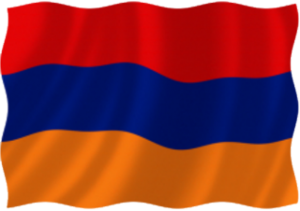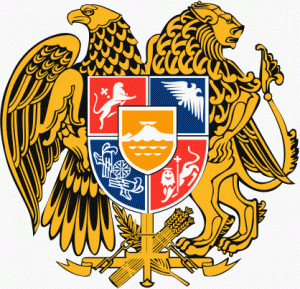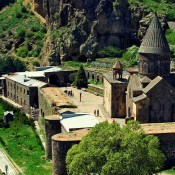geghard
Armenia
Flag of Armenia
 The national flag of Armenia, the Armenian Tricolour (known in Armenian: as Եռագույն, Yeřaguyn), consists of three horizontal bands of equal width, red on the top, blue in the middle, and orange (also described as “colour of apricot”) on the bottom. The Armenian Supreme Soviet adopted the current flag on 24 August 1990. On 15 June 2006, the Law on the National Flag of Armenia, governing its usage, was passed by the National Assembly of Armenia.
The national flag of Armenia, the Armenian Tricolour (known in Armenian: as Եռագույն, Yeřaguyn), consists of three horizontal bands of equal width, red on the top, blue in the middle, and orange (also described as “colour of apricot”) on the bottom. The Armenian Supreme Soviet adopted the current flag on 24 August 1990. On 15 June 2006, the Law on the National Flag of Armenia, governing its usage, was passed by the National Assembly of Armenia.
Throughout history, there have been many variations of the Armenian flag. In ancient times, Armenian dynasties were represented by different symbolic animals displayed on their flags.[1] In the twentieth century, various Soviet flags represented the Armenian nation.
The meanings of the colors have been interpreted in many different ways. For example, red has stood for the blood shed by Armenian soldiers in war, blue for the Armenian sky, and orange represents the fertile lands of Armenia and the workers who work them.[2]
The official definition of the colors, as stated in the Constitution of the Republic of Armenia, is:
The Red emblematizes the Armenian Highland, the Armenian people’s continued struggle for survival, maintenance of the Christian faith, Armenia’s independence and freedom. The Blue emblematizes the will of the people of Armenia to live beneath peaceful skies. The Orange emblematizes the creative talent and hard-working nature of the people of Armenia.[3]
Coat of arms of Armenia

The national coat of arms of Armenia (Armenian:Հայաստանի Զինանշան, Hayastani Zinanshan) consists of an eagle and a lion supporting a shield. The coat of arms combines new and old symbols. The eagle and lion are ancient Armenian symbols dating from the first Armenian kingdoms that existed prior to Christ.
The current coat of arms was adopted on April 19, 1992, by the Armenian Supreme Council decision. On June 15, 2006, the law on the state coat of arms of Armenia was passed by the Armenian Parliament.
Our Fatherland Mer Hayrenik
“Mer Hayrenik” (Armenian: Մեր Հայրենիք, Armenian pronunciation: [mɛɾ hɑjɾɛnikʰ]; “Our Fatherland”) is the national anthem of the Republic of Armenia. Adopted on July 1, 1991, it was also the national anthem of the Democratic Republic of Armenia (1918–1920), the first modern Armenian state.
The lyrics of the anthem are adapted from a version of Song of an Italian girl (Armenian: Իտալացի աղջկա երգը, written in 1859) by Mikael Nalbandian (1829–1866).[1] Later set to music by composer Barsegh Kanachyan (1885–1967).
|
Armenian[2]
|
Latin transcription
|
English translation
|
|---|---|---|
|
Մեր Հայրենիք, ազատ անկախ,
Որ ապրել է դարէ դար Յուր որդիքը արդ կանչում է Ազատ, անկախ Հայաստան։
Ահա եղբայր քեզ մի դրոշ,
Նայիր նրան երեք գույնով,
Ամենայն տեղ մահը մի է |
Mer Hayrenik’, azat ankakh,
Aha yeghbayr k’ez mi drosh,
Nayir nran yerek’ guynov,
Amenayn tegh mahë mi e |
Our Fatherland, free, independent,
Here is a flag for you, my brother,
Look at it, tricolored,
Death is the same everywhere, |
